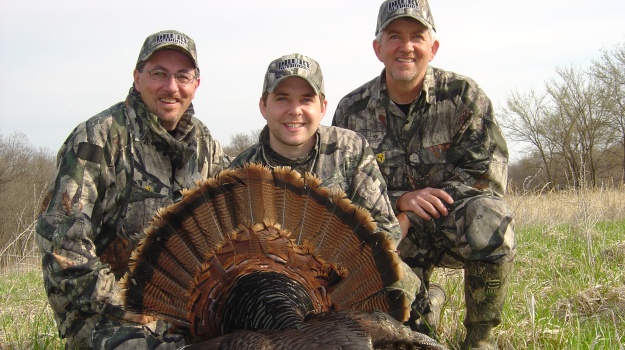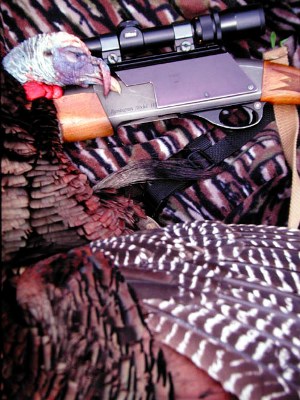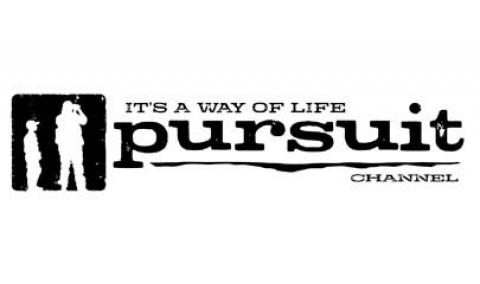
Editor’s Note: Mark and Terry Drury of Drury Outdoors are two of the most-successful TV producers in all of outdoor television. They produce “Bow Madness,” “Dream Season,” “Wildlife Obsession” and “King of the Spring” that air on the Outdoor Channel, and “Natural Born” that airs on the Pursuit Network. They’re brothers, business partners, friends and hunting buddies.
Question: Terry, why do you think putting a riflescope on your shotgun drastically has increased yours and Mark’s abilities to take turkeys?
Terry Drury: Mark and I started out putting red dot riflescopes on our turkey shotguns. We found we could aim much more accurately and better using those types of scopes. But now Nikon has started to make a wide variety of turkey scopes, including crosshairs and BDC reticules. These new riflescopes help you aim better and judge distance better, and they’re brighter than ever. So, you can see the turkey’s head better than you ever have during the past. Also by using movable reticles when you first sight your shotgun in, if your pattern is to the left, to the right, high or low, you can aim at the densest part of the pattern after you’ve shot. Then you can move the reticles, so they line-up with the densest part of the pattern. This way you’ll know for certain, when you put the red dot or the crosshairs at the base of the turkey’s neck, your gun will deliver the densest pattern to the spot you want to hit. Many people say, “A scope limits my vision. If a turkey moves quickly, I won’t be able to pick him up in the scope.” My answer to that objection is that no one has worse eyesight that I do. I’ve had terrible eyesight all my life, and Mark’s isn’t much better. We both wear glasses, and I’ve had Lasik surgery. But I’ve learned, once you start shooting with the scope and get accustomed to shooting turkey with a riflescope, you’ll become more comfortable looking through the scope.
 One of the biggest advantages that a deer hunter has for using scopes on his turkey shotgun is that he’s already accustomed to sighting with a scope. So, when he changes seasons from deer season to turkey season, he still can use the same sighting system that he’s used when he deer hunted – looking through the scope, picking out the spot he wants to shot and squeezing the trigger. The more you practice shooting a turkey head target with a scope, the better you’ll going to get with it. I don’t just shoot off a bench. I sit down and lean up against a bench, just like I’ll be shooting in the woods. I also practice bringing the gun to my shoulder quickly and getting the shots off fast at a paper target. You need to learn as much as you can about shooting with a scope, before you go turkey hunting.
One of the biggest advantages that a deer hunter has for using scopes on his turkey shotgun is that he’s already accustomed to sighting with a scope. So, when he changes seasons from deer season to turkey season, he still can use the same sighting system that he’s used when he deer hunted – looking through the scope, picking out the spot he wants to shot and squeezing the trigger. The more you practice shooting a turkey head target with a scope, the better you’ll going to get with it. I don’t just shoot off a bench. I sit down and lean up against a bench, just like I’ll be shooting in the woods. I also practice bringing the gun to my shoulder quickly and getting the shots off fast at a paper target. You need to learn as much as you can about shooting with a scope, before you go turkey hunting.
But I know, at least for Mark and me, the number of turkeys we’ve had a chance to harvest has gone up dramatically, and the number of misses has gone down tremendously. So, we’ve become total believers in shooting with turkey optics on our turkey shotguns.
Another problem that you can solve with optics is canting the shotgun (turning the stock of the gun to the left or the right as you try and get off the shot). If you’re looking at your crosshairs, and they’re level, you know you’re not canting the shotgun. But if one crosshair is a little higher than the other one, you know you’re canting; you need to straighten your gun, before you take the shot. Many hunters miss when the turkey steps out from behind a bush or a tree and the hunter’s preparing to take the shot. Instead of moving the gun on his knee, he’ll lean to the left or the right. When he leans, the gun isn’t parallel to the ground, and he misses. Many times you won’t know why you’ve missed. But oftentimes it’s because you’ve canted the shotgun and moved your aiming point. We’ve found that putting scopes on our shotguns has helped to solve this problem. Plus, we get a brighter and clearer picture of the turkey’s head in the riflescope than we do when we’re looking at the bead and trying to see the turkey’s head.
These turkey-hunting tips and tactics are some Mark and I have learned. We hope they’ll help you bag more gobblers this season. Don’t forget wear Mossy Oak camouflage from your head to the soles of your boots to become invisible in the woods.
Day 4: Better Guns, Shells, Chokes and Optics for Hunting Turkeys with Terry Drury



























